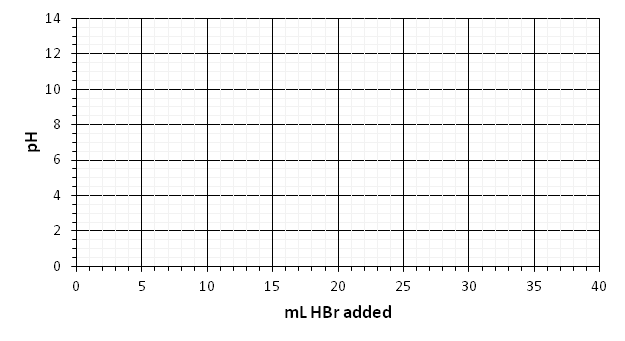Acid-Base Titrations (Mullaugh)
- Page ID
- 282806
\( \newcommand{\vecs}[1]{\overset { \scriptstyle \rightharpoonup} {\mathbf{#1}} } \) \( \newcommand{\vecd}[1]{\overset{-\!-\!\rightharpoonup}{\vphantom{a}\smash {#1}}} \)\(\newcommand{\id}{\mathrm{id}}\) \( \newcommand{\Span}{\mathrm{span}}\) \( \newcommand{\kernel}{\mathrm{null}\,}\) \( \newcommand{\range}{\mathrm{range}\,}\) \( \newcommand{\RealPart}{\mathrm{Re}}\) \( \newcommand{\ImaginaryPart}{\mathrm{Im}}\) \( \newcommand{\Argument}{\mathrm{Arg}}\) \( \newcommand{\norm}[1]{\| #1 \|}\) \( \newcommand{\inner}[2]{\langle #1, #2 \rangle}\) \( \newcommand{\Span}{\mathrm{span}}\) \(\newcommand{\id}{\mathrm{id}}\) \( \newcommand{\Span}{\mathrm{span}}\) \( \newcommand{\kernel}{\mathrm{null}\,}\) \( \newcommand{\range}{\mathrm{range}\,}\) \( \newcommand{\RealPart}{\mathrm{Re}}\) \( \newcommand{\ImaginaryPart}{\mathrm{Im}}\) \( \newcommand{\Argument}{\mathrm{Arg}}\) \( \newcommand{\norm}[1]{\| #1 \|}\) \( \newcommand{\inner}[2]{\langle #1, #2 \rangle}\) \( \newcommand{\Span}{\mathrm{span}}\)\(\newcommand{\AA}{\unicode[.8,0]{x212B}}\)
Learning Objectives
Following this activity, students should be able to:
- Determine the pH at any point throughout an acid-base titration including the titration of:
- A strong acid with a strong base
- A strong base with a strong acid
- A weak acid with a strong base
- A weak base with a strong acid
- Describe the general nature of the solution in terms of how to calculate pH for the following regions of an acid-base titration:
- Region I: before any titrant added
- Region II: partway to the equivalence point
- Region III: at the equivalence point
- Region IV: past the equivalence point
- Compare how concentration and strength of an acid or base changes the appearance of a titration curve.
Consider the following titration…
What is the pH at the following points described for the titration of 75.0 mL of 0.0874 M trimethylamine, (CH3)3N, with 0.250 M HBr. Trimethylammonium, (CH3)3NH+, has a pKa = 9.80.
- Circle one from each four pairs of words. The titration described is the titration of a (weak/strong) (acid/base) with a (weak/strong) (acid/base).
- Write the overall reaction between the analyte and the titrant. What is the titrant and what is the analyte in this titration?
- What is K for the reaction as written? What does the magnitude of K tell you about the reaction?
- What is the initial pH of the (CH3)3N solution before any HBr is added? (Region I)
- What is the pH after the addition of 10.0 mL 0.250 M HBr? (Region II)
- What is the equivalence point (Ve)? What is the pH at the equivalence point? (Region III)
- What is the pH after 35.0 mL HBr is added? (Region IV)
- How would you describe the solution at each of the previous four point in the titration?
Question
Region
HBr added*
The solution is a…
#4
I
V = 0 mL
#5
II
V < Ve
#6
III
V = Ve
#7
IV
V > Ve
*Volume (V) of titrant added with Ve = equivalence point.
- Using your calculations above, sketch what the titration curve would look like. Label the equivalence point.

- At what point is the pH equal to the pKa of (CH3)3NH+? Label this point on the graph above.
- Discuss how your group how the titration curve above would differ if the following changes were made:
- The initial concentration of trimethylamine was lower.
- Instead of trimethylamine, potassium hydroxide (KOH) was the analyte.
- Instead of trimethylamine, analine was the analyte. The conjugate acid of analine has a pKa = 4.601.
- The initial concentration of trimethylamine was lower.
Contributors and Attributions
- Kate Mullaugh, College of Charleston (mullaughkm@cofc.edu)
- Sourced from the Analytical Sciences Digital Library


